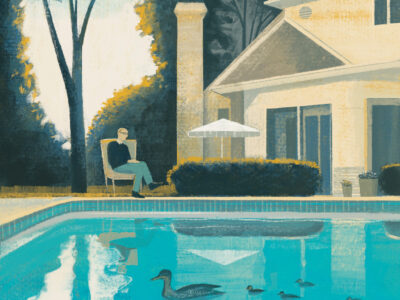
Class of ’93 | When Matt Selman C’93 was a history major at Penn, he had no idea that he’d find himself weaving his own undergraduate experiences into the fictional history of a certain animated TV family. Having Marge Simpson taking the same classes as he did, for example.
Selman has written for The Simpsons, the award-winning Fox television show, for 11 years. Given that the show’s writing staff is known as a bastion of Harvard alumni—Crimson references pepper the series’ 19 seasons—it’s no wonder that Selman is proud of having incorporated some Penn images into the series.
In the current season’s “That ’90s Show,” Marge and Homer recall their days as a young couple. While Marge makes googly eyes at her history professor, “Stefan August,” a grunge-era Homer runs amok on the campus. Claes Oldenburg’s “Button” sculpture is drawn into the background as Homer cringes over Marge’s possible romantic betrayal.
Selman credits his knowledge of revisionist history and colonialism to his professors at Penn, and revisionist history is the first topic of the day in Marge’s Cultural History class, taught by her would-be love interest. The episode lampoons the decade’s PC ethos: As Stefan and Marge stroll down a beach, Stefan describes the local lighthouse as an egregious example of “phallo-centric technocracy.”
Later, Stefan is conscious of potential sexual harassment as he comes on to Marge. “If I were to approach you for a kiss, would you consider that harassment, or give your willing consent?” he asks.
“I consider this a love letter to Penn,” says Selman. “It was really fun to give the nineties a cultural identity, which no one has really done before.”
Before making his mark on the screen, Selman considered journalism—he interned as an undergrad at Philadelphia magazine, and was a Gazette student columnist in 1992-93—and graduate school, but decided to try his hand at comedy-writing instead.
“My parents probably thought I was insane,” he says, “but I figured it’d at least be more fun than law school.”
After graduation, Selman moved to Los Angeles and submitted sample material to television shows. “Two years of broken-ness” later, he got his first big break: The producers of Seinfeld gave him a call, and in 1996, he helped pen “The Wait Out,” a Seinfeld sixth-season favorite. A year later, he started writing for The Simpsons. He says that he “kept his head down” at first to get a sense of how things worked on the show, and his strategy paid off: As a writer for more than 12 seasons, he’s now one of the show’s veterans.
Having helped write last year’s The Simpsons Movie, Selman was a guest of honor at 2007’s Comic Con—where he loudly sang the movie’s “Spider-Pig” theme song with the movie’s other writers.
Selman is proudest of his most recent episodes. He speaks fondly of “Husbands and Knives,” his “nerdy episode” where avant-garde comic-book authors Art Spiegelman and Alan Moore become super-heroes flying over Springfield. Then there’s Emmy-nominated “The Haw-Hawed Couple,” in which Bart and stereotypical bully Nelson become best friends.
“That 90’s Show” is high on his list of favorites, not just because of the Penn references but because Selman also likes playing with paradox.
“No other show on the air has done a flashback show that literally took place when the show also existed,” says Selman, who credits the The Simpsons’ uncommon longevity for this unique opportunity.
While some Simpsons fans were furious about the supposed lack of continuity the episode presented—previous episodes had established that Marge and Homer married in the ’70s—Selman shrugs off that criticism.
“One of the greatest things about the show is that our passionate fan-base loves to hate with ardor,” he says, “but to me, I thought the episode was pretty clear. It was sort of a flight-of-fancy, and not a serious attempt to rewrite the show’s continuity. It was a fun way to do a different story in a time period that no one had ever made fun of. The characters never age, and so any attempt at continuity is impossible. You sort of have to give up and have fun with it. The classic episodes with Homer and Marge will always be the emotional heart of the show.”
The episode aired in January, while the Writer’s Guild of America was on strike. Selman avidly participated in the strike, and was even featured on YouTube’s “Virtual Picket Line” channel. He also began writing “Nerd World,” a geek-culture blog co-written with Lev Grossman for Time magazine. He brings his snarky Simpsons sensibility to the blog: One post ironically and exhaustively details bookshelf-display etiquette, and another proposes party games for the anti-social geek.
Selman’s participation in the strike reflects his awareness of the “TV bubble” that has burst in recent years. While he’s unquestionably had a successful career, his prognosis for the future of comedy writing in the age of Internet-centric entertainment is grim. Asked to give advice for prospective comedy writers, he replies: “Shoot yourself. Or do it for the love—not for the money. Or invent a time machine to go back to the early ’90s.”
In a way, Selman already did.
—Jessica Haralson C’08




